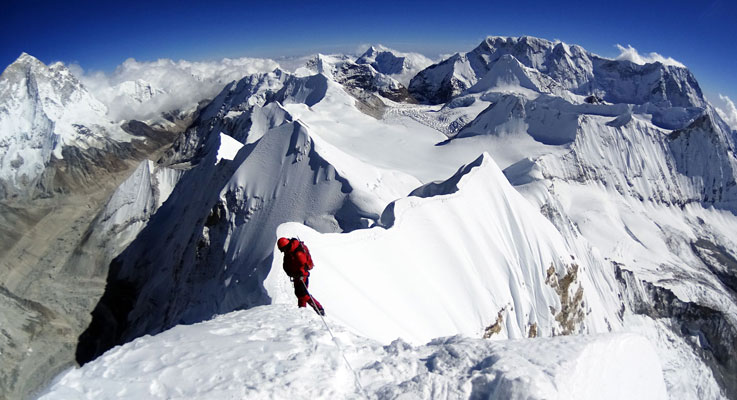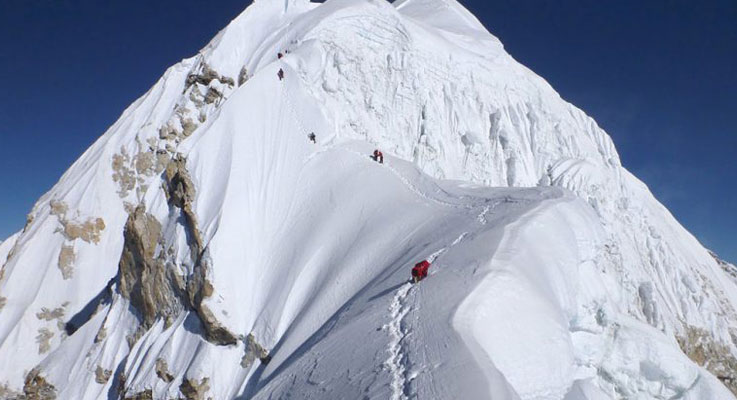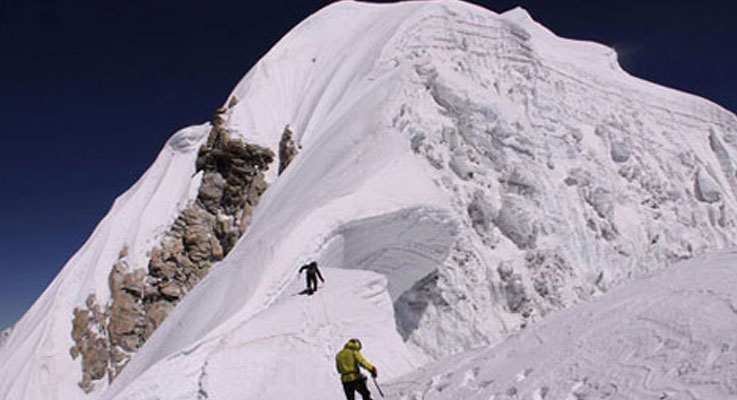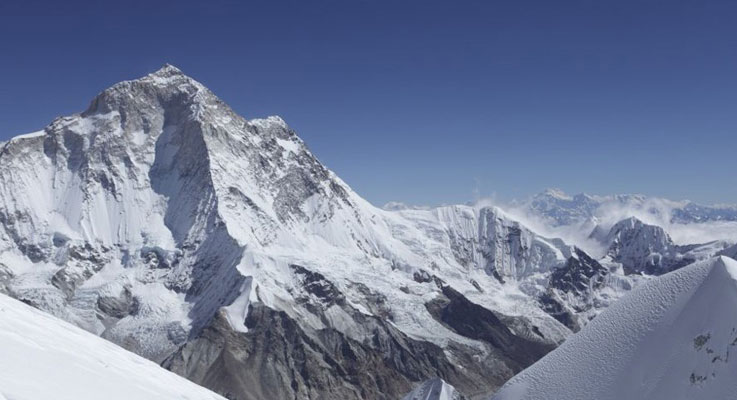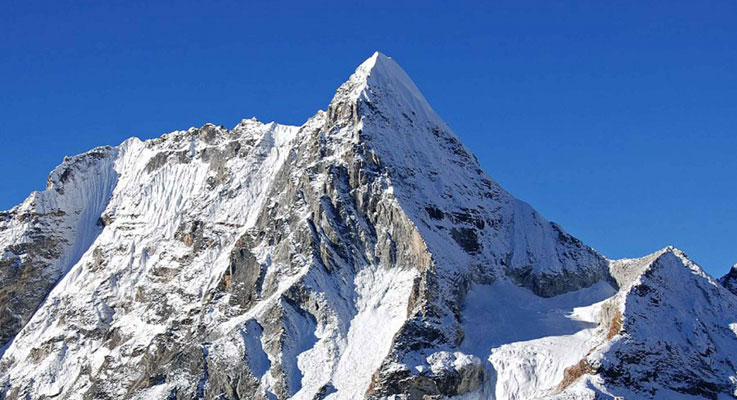-
Day 1
Arrival in Kathmandu (1,345m/4,413 ft)
Upon arriving at at Tribhuwan International Airport in Kathmandu, you will be received by our airport representatives who will warmly greet you and transfer to the hotel on a private tourist vehicle. We provide 3-star accommodation in the city and we arrange for a trip briefing with dinner in the evening.
-
Day 2
Visit old town of Kathmandu
A professional guide and vehicle are provided for a day of sightseeing in and around Kathmandu city. We visit some of the UNESCO World Heritage Sites in the city along with other interesting cultural monuments that dot the valley. These include Boudhanath Stupa (the largest Buddhist shrines in the world), Pashupatinath (the holiest Hindu temple in the world), Durbar Squares (Palaces and fortresses of medieval Kings), along with other popular cultural attractions. We get to observe the lifestyle of Nepalese people, holy sadhus and monks, fascinating history as well as awe-inspiring architecture.
-
Day 3
Official formalities in Kathmandu.
Formal briefing at the Ministry of Tourism. The expedition leader will check that everyone’s equipment is in working order. Overnight at Kathmandu hotel.
-
Day 4
Final preparation day in Kathmandu.
Final opportunity for last-minute purchases. Overnight at Kathmandu hotel.
-
Day 5
Fly to Lukla trek to Chutok.
An early morning start takes us to Tribhuwan International Airport in Kathmandu for the 35 minute scenic flight to Tenzing and Hillary Airport in Lukla (2804m). Upon arrival at the airport, a guide will meet us and introduce the porters before we begin the three hour trek up to the Chutok La pass (2945m). Overnight at tented camp (2800m).
-
Day 6
Trek to Col Khari La & Pangkongma.
After the pass of Col Khari La (3081m), the trail weaves along mountain sides through the Khari Khola valley to set up camp in Pangkongma (2950m), a six hour trek. Overnight at tented camp.
-
Day 7
Trek to Kurke.
A magnificent five hour route takes us along mountain crests through rocky and wild landscapes. Passing through, we’ll enjoy the splendid panorama of the wooded regions below us. The day ends at Kurke (3800m). Overnight at tented camp.
-
Day 8
Trek to Thuli Kharka.
Today we climb for six hours up to a pass at 4400 meters and then descend to Thuli Karkha (4200m), which means "vast pasture". Overnight at tented camp.
-
Day 9
Trek to Khothey .
We descend for five hours down hillsides, passing pleasant meadows and then down through forests of blue Himalayan pines and rhododendrons. The trip is accompanied by beautiful views of the south side of Mera Peak. The day ends at Khothey (3600m). Overnight at tented camp.
-
Day 10
Trek to Tangnag.
We climb up the Hinku Valley through summer pastures. Near Lungsamba the valley narrows, wedged between the Kusum Kangru (6369m) and the west summit of Mera Peak (6255m). After a six hour walk we reach Tangnag (4350m). Overnight at tented camp.
-
Day 11
Acclimatization day at Tangnag.
A day will be spent here resting and adjusting to the high altitude. Overnight at tented camp.
-
Day 12
Trek to Khare.
We climb up along the lateral moraine of the Dig Glacier, which provides fascinating views of Mera Peak. We arrive at Khare (4900m) after four hours. Overnight at tented camp.
-
Day 13
Trek to Mera La & base camp.
Progressing along the snowy glacier, we approach the mountain pass, where the slope becomes steep. The day’s five hour trek takes us through Mera La (5415m) at the base camp (5300m). Overnight at tented camp.
-
Day 14
Climb Base Camp to High Camp.
Today holds one of the best parts of the trek. We see stunning panoramas of giant mountains rising above 7000 meters, some of the highest on earth: Chamlang (7290m), Makalu (8475m) and Baruntse (7220m), Everest (8848m), Lhotse (8501m) and Nuptse to the north. Continuing westward, the peaks of Ama Dablam, Cho Oyo (8153m) and Kantega fill our view This five hour trek takes us to the high camp (5800m). Overnight at tented camp.
-
Day 15
Trek to Mera Peak summit.
Weather permitting, we begin early in the morning for the trip up to Mera Peak and back down. Overnight at tented camp.
-
Day 16
Trek to Khare.
We climb down toward Khare along the lateral moraine of the Dig Glacier, providing interesting views of Mera Peak. Overnight at tented camp.
-
Day 17
Trek to Baruntse base camp.
This day leads us toward the starting point of our prime destination which takes about 7 hours. We spend our night at tented camp. Over night at tented camp.
-
Day 18
Rest and acclimatization day at Baruntse base camp.
This is very important day for climbing purposes. We’ll adjust to the altitude and rest, preparing ourselves physically and mentally for the climbing mission. Overnight at tented camp.
-
Day 19-31
Climbing period
When we are physically and mentally ready, we begin our climb. After all the cclimbing we’ve done already, the ascent seems less difficult. To make the climb successful, we establish two camps above Baruntse base camp. Two camps are set up above the base camp for climbing purposes. Camp 1 is set up just below the East Col. at an altitude of 5700m, and the Baruntse Camp 2 is on the southeast ridge at an altitude of 6420m.
Above Camp 1, we climb up snow slopes at a 50 degree angle, past a subsidiary summit (6745m). From here the route becomes more complex. A series of short, steep steps of snow and ice are gained until we pass onto the west side of the ridge. Some short sections of rock scrambling lead back onto the ridge until it narrows at about 7000m. This leads to a marked cleft and an ice cliff, after which we have access to the easier, broader slopes above. These lead to the summit at 7129m. The trek takes approximately ten hours. After attaining the summit of Baruntse, we descend by the same route.
-
Day 32
Rest and cleanliness program in Baruntse base camp.
As the base camp has been our home for several days, we take the time to clean the area of our traces, a very important part of responsible ecotourism. The remainder of the day will be spent resting and enjoying the spectacular Himalayan views.
-
Day 33
Trek back to Seto Pokhari camp.
Having climbed two of the world’s most important and challenging peaks, we descend to Seto Pokhari. Overnight at tented camp.
-
Day 34
Trek to Mera Peak base camp.
Overnight at tented camp.
-
Day 35
Trek to Khothey.
Leaving the mountains behind us, our six hour descent takes us through Tangnag before continuing back to Khothey (3600m). Overnight at tented camp.
-
Day 36
Trek to Thuli Kharka.
Our trek descends back the same way for another six hours, until we reach Thuli Kharka. Overnight at tented camp.
-
Day 37
Trek to Lukla.
Finally we make the seven hour return to Lukla (2804m), where the trek began. We’ll take time to reflect on the trek as a group, and the personal achievements of all who took part. You’ll also have plenty of time to explore the town. Overnight at guesthouse.
-
Day 38
Morning flight back to Kathmandu.
On the scenic thirty-five minute flight back to Kathmandu, you’ll enjoy a last glimpse of the mountains you have recently climbed. Upon arrival in Kathmandu we’ll be met and transferred back to the initial hotel. Overnight at Kathmandu hotel.
-
Day 39
Leisure day in Kathmandu
This is a leisure day for exploration. You are free to go souvenir shopping, spa and more exploration of the city, or extend your trip to include bungee jumping, rafting, mountain biking, Everest mountain flight and other adventurous activities. In the evening, we will have a farewell dinner at Mul Chowk Restaurant’s cozy and elegant dining ambience.
-
Day 40
Departure from Nepal
The trip concludes today. You will be dropped at Kathmandu's Tribhuwan International Airport by our airport representative for your flight departure from Nepal.

